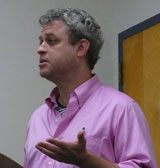

![]()
::: resident
fellowships
::: associateships
![]()
being here
::: visiting
::: the last donut
::: photo album
::: center home >> people >> postdoctoral fellows >> curiel |
||||
| Erik Curiel Abstract: One can (for the most part) formulate a model of a classical system in either the Lagrangian or the Hamiltonian framework. Though it is often thought that those two formulations are equivalent in all important ways, this is not true: the underlying geometrical structures one uses in each case to express the equations of motion are not isomorphic. This raises the question whether one of the two is a more natural framework for the representation of classical systems. If one restricts oneself to the family of classical system whose possible interactions with the environment satisfy a weak condition (which all known classical systems in fact do), the answer is yes: I state and sketch the proof of a theorem, in the context of the intrinsic geometry of tangent bundles, to the effect that Lagrangian mechanics is the more fundamental representation of any such system. I conclude with a brief discussion of the result’s relevance for several problems of philosophical interest, including: the type and amount of knowledge of a physical system one must have in order to determine structures of intrinsic physical significance it manifests; the seeming inevitability of the presence of arbitrary elements in every model we can construct of a physical system; and the cogency of structural realist accounts of physical systems. 2016 Update Erik Curiel was awarded a EUR 300,000 grant from the Deutsche Forschungsgemeinschaft, to fund a three-year project entitled "Gravity, Thermodynamics and Quantum Field Theory: The Cross-Roads of Physics and Philosophy". He has been appointed Assistant Professor at the Munich Center for Mathematical Philosophy (LMU) to carry out work on the project. He has had papers accepted in *British Journal for the Philosophy of Science* ("On the Existence of Spacetime Structure"), *Studies in History and Philosophy of Modern Physics* ("On Geometric Objects, the Non-Existence of a Gravitational Stress-Energy Tensor, and the Uniqueness of the Einstein Field Equation"), and *Classical and Quantum Gravity" ("A Simple Proof of the Uniqueness of the Einstein Field Equation in All Dimensions").
|
|
|||
